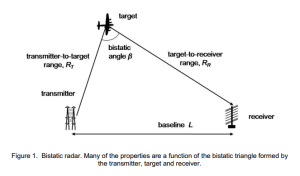Radar is an English word originated from an acronym which stands for Radio Detection and Ranging. This electronic device, as you probably can tell, is a device which could detect the presence of an object (or target) and estimate its distance. It illuminates the target by transmitting radio waves. Once the waves reach the target it will be reflected and will be received again by the radar. By knowing the speed of the wave (which is constant), we can measure how distant the target is from our radar.
Nowadays, one of interesting research topics in radar is bistatic radar. In this type of radar, the transmitter and the receiver of a radar system are separated in a particular distance. By using geometry, we can determine the location of the target. This configuration of radar was also used to measure the ionosphere.
What makes it interesting is it turned out that the principle of modern bistatic radar (which is currently the hot topic) was actually being used during the World War 2, about 60 years ago. It was the German air defence system which installed a few unit of receivers which could act as passive radars receiving the waves illuminated by British transmitter.

The radar (image source:http://www.gyges.dk/Klein%20Heidelberg.htm)
It was the perfect example on how to you use the enemy defence system for your own defence system (counter-countermeasure). It was brilliant, about 60 years ahead of its time. It’s considered as the first hitchhiker. By utilizing the illumination from British transmitter, Klein Heidelberg could locate the British aircraft flying from England to Germany. And since it was only a passive receiver, it was not detected as a target.
The Kein Heidelberg succeeded on increasing the loss rate of British bomber aircraft. Unfortunately, the British finally discovered the existence of those radars, trying to disassemble and learn the system. But still, it’s so amazing how such a bistatic radar existed 60 years ago while radar researchers are currently exploring the idea. Genius!
*this post is written after I attended a seminar by Huggh Griffiths (the President of IEEE Aerospace and Electronic Systems Society) in the previous week. The picture in this post is taken from his paper [http://www.cdvandt.org/K-H%20final.pdf]
